So, you didn’t get the superhero cape with your leadership title and role?
Whilst at times you may feel you are required to exhibit superhero strength and capabilities, a superhero you are not. This means that you will most likely express the range of emotions that most humans experience at one point or another. The whole range! It would be useful if at times we could conceal some of those emotions (maybe all of them) but we cannot. We experience what all mere mortals experience because we are NOT superheroes.
How do we keep our emotions in check when we are the leader? A leader is often portrayed as being calm, steady, and grounded. When we lead using this style, our teams feel safe, secure, and confident in the ability of the team to achieve its goals. Conversely though, concealing emotions, and not letting our team and others around you really see what you are feeling can be perceived as disingenuous. People may lose confidence and not trust in your ability to lead.
So, do you show your emotions, or do you conceal them? How easy or hard is that to do?
As with all big questions, one simple answer does not exist.
The research suggests that having an awareness of the impact of our emotions and how to regulate them is important for leaders. An awareness of how emotions can motivate us can be helpful.
We also know that having an awareness of how our brains react to certain situations, can positively impact our ability to have better control over a situation. We may not be able to control our physiological response to a threatening or stressful situation, but an awareness of what is happening as we are faced with responding to it can help to slow us down and be more proactive rather than reactive.
This model may help in slowing you down so you can be aware of your emotions and how you would like to respond to a situation.

The ARIA model has been developed to encourage a pause before we act.
Firstly, we become aware of what is happening. We come out of our bodies and observe our reaction. No judgment. Just awareness. Here we are observing our physiological and emotional reaction to the situation. Secondly, we stop to reflect. We pause. We consider the situation. We are not reacting here, we are reflecting. How is this situation making us feel? What is the impact of this situation? Thirdly we develop insights. The pause has provided us with the time to clear our heads, to think more strategically, engaging the pre-frontal cortex of our brain. It may feel unnatural to do this in a stressful situation, but it is worthwhile not acting in that moment. Here we are reducing the confusion and creating a clear path for quality thinking. Finally, we move into action. We have had time to become aware of the situation and its impact. We have reflected and paused to gather our thoughts and we have developed insight before we act.
By following this model, we avoid quick reactions, and we engage in more proactive thinking. This helps to keep emotions in check, so they don’t flood our ability to think. We are aware of our emotions, and we can be more mindful about how those emotions are displayed to others, and whether we want to display them or not.
Our emotions are a powerful internal alert system. We don’t want to ignore them, and we don’t want them to take over our ability to think clearly. We do want to use them positively and mindfully so we can feel confident in our leadership ability.
Rita Cincotta writes, mentors, and speaks on individual and team performance, leadership development, resilience and new ways of working. She works with organisations to develop human centred solutions that help people and businesses to thrive.

